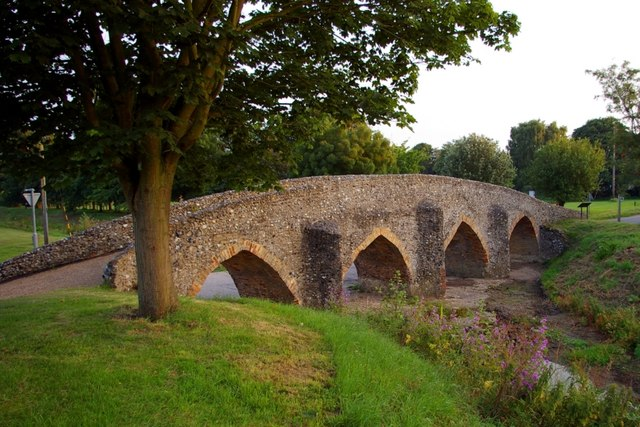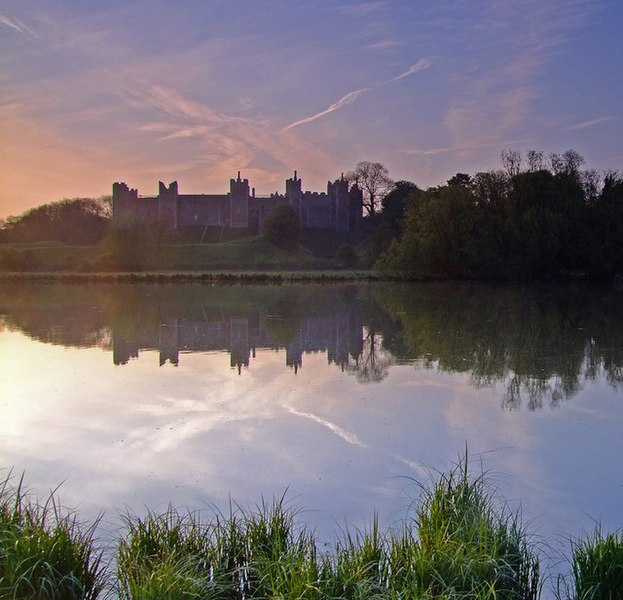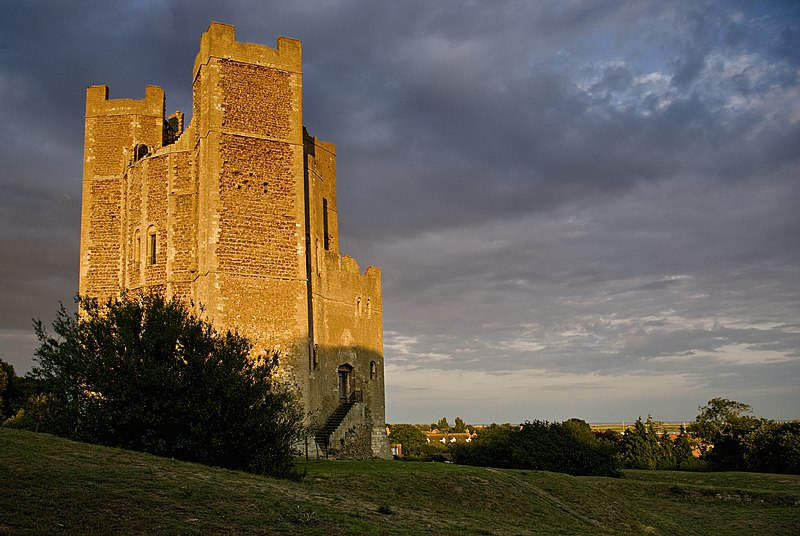English Heritage properties serve to preserve and promote the incredible historic environment of Britain and East Anglia and ensure that the colourful past of England is thoroughly comprehended. Suffolk’s English heritage sites range from understated bridged to dramatic castles with the stunning Suffolk countryside as their backdrop. Many of these heritage sites play host to a variety of events year-round. From discovering the impressive ruins of massive circular pillars and towering walls to magical walks through secret gardens, Suffolk is jammed packed with extraordinary sites to visit.

Moulton Packhorse Bridge
One of these English Heritage sites is Moulton Packhorse Bridge, a beautiful medieval bridge with four arches. The Moulton Packhorse bridge spans the River Kennett on the old path from Bury St Edmund to Cambridge, with the lovely village of Moulton situated nearby. Moulton is even older than Newmarket, pre-dating the 1086 Doomsday book. This site welcomes the public all year.

Framlingham Castle
A fantastic example of a castle from the 12th century, Framlingham Castle is an architecturally significant castle with a curtain wall displaying mural towers. The crenellated towers, impressive stone wall, and Tudor chimneys nestled in grassy earthworks are a subtle reminder of Britain’s outer defences and the vast network of influence and power that used to frequent this incredible site in East Anglia. The mere, situated to the west, offer gorgeous views of the Suffolk landscape and picturesque lake at Framlingham Castle. Within the towering walls of this castle, Mary Tudor was named the first Queen of England.

Bury St Edmunds Abbey
Bury St Edmunds Abbey boasts the impressive monastic ruins of the most powerful and richest Benedictine Abbey in the UK. The Abbey includes the full 14th-century Norman Tower, Great Gate, the altered west end, and astonishing ruins of the immense church. At the Bury St Edmunds Abbey, you’ll get to explore the extensive remains of the most powerful Benedictine monasteries England has ever seen, which is undoubtedly the shrine of Bury St Edmunds.
The Saxstead Green Post Mill
Saxstead Green Mill is a working corn mill that revolves around its base. Dating back to the 13th century, the mill is a popular tourist attraction and invites visitors to start their journey on the ground floor and explore all the various floors showcasing incredible machinery. The Saxstead Green Mill is located within easy reach of Framlingham Castle, so it is certainly worth a visit when you are travelling this area.
Find the opening hours and relevant fees for Saxted Green Post Mill.

The Leiston Abbey
The Leiston Abbey is one of Suffolk’s most magnificent ruins of a monastery. In the past, the Abbey was known as St Mary’s Abbey and was founded at Minsmere in 1182 by an influential lawyer, Lord Chief Justice to King Henry II, Ranulf de Glanville. The order of Leister Abbey consisted of a House of Augustinian Canons Regular who adhered to Premonstratensian rule. They differed from monks in that their primary duties involved pastoral work and preaching.

Orford Castle
The distinctive polygonal keep found at the Orford castle stands beside the charming village and the port that was developed in the 1160s by Henry II. Both the interior and the exterior of Orford castle are completely intact and thus make for a great opportunity for visitors to explore the impressive lower and upper halls and the well in the basement. The polygonal rooms are structured with a maze of various passages that lead to important chambers in Orford castle. Visitors can take in the magnificent views of Orford Ness National Nature Reserve from the roof.
Felixstowe Museums
Felixstowe Museums consists of fourteen display rooms holding both military and social history. This 18th-century submarine miming establishment is home to a lovely tearoom and shop. Visitors can also find unique exhibitions for 2008 that commemorate the 90th anniversary of the RAF formations when World War 1 came to an end.
Landguard Fort
Landguard Fort is famous for being the place where the last opposed invasion of the UK took place in 1667, as well as being the site of the first land battle the Royal Marines fought. The Fort was originally built in the 1800s and modified in the 1900s. Visitors can enjoy audio tours and guided tours of the grounds, where they will receive a supplementary DVD that presents the interesting history of the site. Situated close by is the Felixstowe Museum, housing many collections of local interest.
Landguard Fort was manned throughout both World Wars I and II and played a significant role in the second World War as an anti-aircraft entity. A Cold War control room originated from two old gun casemates back in 1951, and the Fort was closed and disarmed in 1956. The maritime and military heritage at Landguard Fort is extensive and certainly worth exploring through various rooms and the maze, which children will find particularly exciting.
The current Fort hosts a wide selection of worthwhile events throughout the year, including spooky scares, children’s quiz trails, and historical re-enactments.
St James’ Chapel
Nestled on the road to Kersey, St James’ chapel in Lindsey is a charming 13th-century chapel boasting lancet windows that served as a chantry to Lindsey Castle nearby back in the day. The bailey earthworks and traces of the motte are some of the only parts of the castle that survived, but the chapel itself survived the entire Reformation and became a barn for nearly 400 years. The chapel is open to the public without charge year-round.
English Heritage Sites Near Suffolk
St. Botolph’s Priory, Essex
The extensive remains of one of the first Augustinian priories in the UK, St Botolph’s Priory, dates all the way back to 1100. These magnificent buildings were built with reused Roman brick and feature round arches, massive circular pillars, and an elaborate west front. This extraordinary structure was damaged in 1648 during the Civil War.
St John’s Abbey Gate, Colchester
Another one of the handfuls of powerful Benedictine monasteries sits at this pinnacled gatehouse, the Abbey of St. John. Parliamentarian soldiers stormed and bombarded the gatehouse during the Civil War siege.
Berry Pomeroy Castle, Devon
Set within the curtain walls of an earlier castle, this Tudor mansion was developed by the Pomeroy family before financial challenges forced them to sell to the first Duke of Somerset, Edward Seymour. The castle remained in possession of the Seymore family until its abandonment in the late 1700s, excluding the period of the Crown’s forfeit when Edward was executed.
Audley End House, Essex
This impressive 17th-century country mansion is set on the outskirts of Saffron Walden. The house was once a palace and used to be well-known for being one of the most excellent Jacobean houses in the country at that time. Today, the house is only a fraction of its initial size, but it still inspires awe. Audley End House is still the family seat of Lord Braybrooke.
Totnes Castle, Devon
Totnes castle is a well-preserved example of a Norman tower castle in the UK. The curtain wall and stone keep of the castle still remain and date back to the 14th century. Since the Norman Conquest, which took place in 1066, the castle was the capital of the Totnes feudal barony. Breton Juhel built the first castle using wood.
Titchfield Abbey, Hampshire
Titchfield Abbey came about for Premonstratensian canons, and Henry VIII closed it in 1537. The structure was then converted by Thomas Wriothesley to result in a mansion. The Abbey was then abandoned before being demolished to a certain extent in 1781, leaving only a romantic and astonishing ruin behind.
Why not check out some other Things to Do in Suffolk. Or look up What’s On Suffolk for other great Suffolk activities and ideas.
What’s your favourite English Heritage site or building in Suffolk? Please let us know by Sending us an Email.
